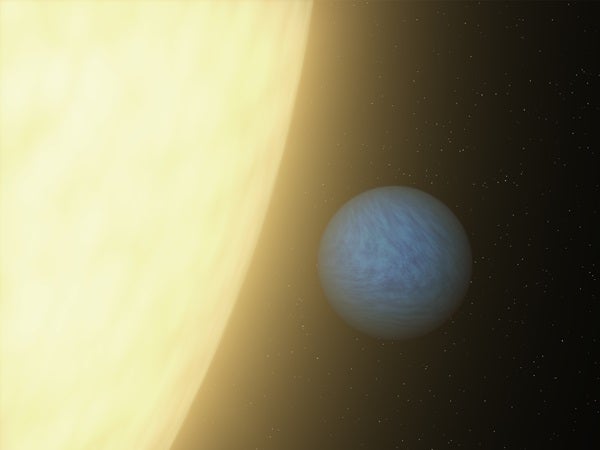Around 440 light years away, there’s a planet a little bigger than Neptune that’s more than meets the eye.
HAT-P-26b seems, by all standards at first, an ordinary hot Neptune. It should theoretically have a composition much like Uranus and Neptune, the latter of which is more dense and compact than the other giant planets in the outer solar system. But despite its size being closer to the ice giants, the actual planet is only a little more dense than Saturn (which is the least dense planet in the solar system.)
So something is amiss. And that something is … water. Or, more accurately, water vapor. At 1,300 degrees Fahrenheit (700 Celsius) the planet is not exactly conducive to somehow being an ocean world. (Nor would it necessarily be at that mass. Despite an abundance of water in Uranus and Neptune, they’re called “ice giants” because atmospheric pressure pushes water vapor into a state known as “hot ice,” where it’s roughly solid but also fairly hot.)
Hannah Wakeford, a postdoc at NASA Goddard who is an author on the study published today in Science, says that the planet is primarily made of a rocky core and a dense envelope of water, with a hydrogen helium atmosphere of about 15-30 percent the mass of the planet. Hubble observations suggest its relatively free of other contaminating heavy “metals, which is anything above hydrogen and helium on the periodic table.
“What we find is that unlike Neptune and Uranus in our solar system, which have over 100 times the amount of heavy elements as the sun, HAT-P-26b has a low metallicity more like that of Jupiter despite its low Neptune-mass,” Wakeford says. “This bucks the trend seen in the solar system where decreasing mass results in increasing metallicity.”
You might then consider the world, which orbits its K-type star in four days, a hot mini-Jupiter or Saturn instead of an ice giant type world. It also probably formed differently from the ice giants. The abundance of water vapor (nearly 90 percent of the composition of the planet) and the lack of heavy elements suggest a snug formation close in to the star.
“From this we can get clues as to the formation of the planet, which suggest it formed closer to its star than similar mass planets Neptune and Uranus in our solar system, and as a result has a low metallicity atmosphere,” Wakeford says. “This is different than we expected and have ever seen before with giant planets, giving us insight into planetary systems that might have formed and evolved differently from our own.”










